Japan's Hayabusa2 Asteroid Ryugu Sample-Return Mission in Pictures
Meet Hayabusa2
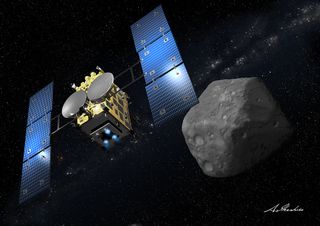
Japan's launched the robotic Hayabusa2 spacecraft and a lander to the deep-space asteroid 1999 JU3, better known as Ryugu, in December 2014. The mission will return samples to Earth by 2020. Hayabusa2 will arrive at Ryugu in late June 2018!
See more photos and images of Japan's Hayabusa2 mission here as it closes in on asteroid Ryugu.
Hayabusa2 Minerva-II1A Landing on Ryugu
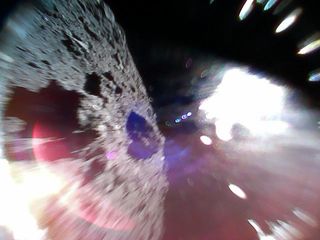
This photo was captured by the Minerva-II1A rover during a hop after it successfully landed on the asteroid Ryugu on Sept. 21, 2018.
Artist's Illustration of MASCOT Lander
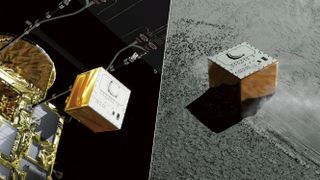
Japan's Hayabusa2 spacecraft successfully dropped the MASCOT lander toward asteroid Ryugu on Oct. 3, 2018 (Japan Standard Time). Left: Illustration of the MASCOT lander separating from the Hayabusa2 mother ship. Right: Illustration of MASCOT landing on the surface of the asteroid Ryugu.
Hayabusa2 Descends Toward Ryugu
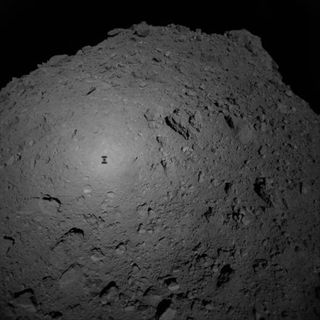
Japan's Hayabusa2 spacecraft descends toward the asteroid Ryugu on the night of Oct. 2, 2018, ahead of the deployment of the MASCOT lander. This photo was taken at an altitude of about 430 feet (130 meters) above Ryugu.
MASCOT Landing Site on Asteroid Ryugu

The MASCOT landing site candidate region (light blue area) on the asteroid Ryugu. Since MASCOT is expected to bounce several times after first touching down, a reasonably wide region was selected.
MASCOT Landing Site on Asteroid Ryugu
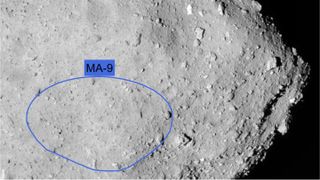
This image of asteroid Ryugu's southern hemisphere, taken by Japan's Hayabusa2 spacecraft, shows the target landing site from the German Aerospace Center's MASCOT lander.
Japan's Hopping Rovers Capture Amazing Views from Asteroid Ryugu
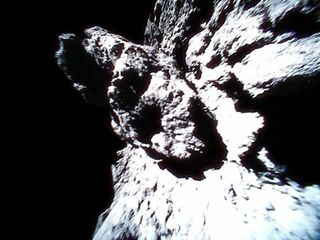
The Minerva-II1A rover captured this close-up shot of a rock formation on asteroid Ryugu on Sept. 22, 2018, at 8:43 p.m. EDT (12:43 a.m. GMT on Sept. 23).
Get the Space.com Newsletter
Breaking space news, the latest updates on rocket launches, skywatching events and more!
MASCOT's Asteroid Landing

An artist's depiction of the MASCOT lander arriving on the surface of Ryugu.
MASCOT on Ryugu

The German Aerospace Center's MASCOT lander, seen here in an artist's illustration, will land on the asteroid Ryugu after being deployed from Japan's Hayabusa2 spacecraft. MASCOT will move around Ryugu by hopping.
Ryugu Up Close

This image of the asteroid Ryugu was captured by Japan's Hayabusa2 mothership from an altitude of about 210 feet (64 meters) on Sept. 21, 2018, just before the craft deployed two tiny, hopping rovers toward the space rock. This is the highest-resolution photograph obtained of Ryugu's surface to date.
Hayabusa2's MINERVA-II1 Rovers

An artist's illustration of Hayabusa2's MINERVA-II1A and MINERVA-II1B rovers exploring the surface of the asteroid Ryugu. The little robots hop by rotating an internal "torquer" that sits atop a turntable.
Join our Space Forums to keep talking space on the latest missions, night sky and more! And if you have a news tip, correction or comment, let us know at: community@space.com.

Tariq is the Editor-in-Chief of Space.com and joined the team in 2001, first as an intern and staff writer, and later as an editor. He covers human spaceflight, exploration and space science, as well as skywatching and entertainment. He became Space.com's Managing Editor in 2009 and Editor-in-Chief in 2019. Before joining Space.com, Tariq was a staff reporter for The Los Angeles Times covering education and city beats in La Habra, Fullerton and Huntington Beach. In October 2022, Tariq received the Harry Kolcum Award for excellence in space reporting from the National Space Club Florida Committee. He is also an Eagle Scout (yes, he has the Space Exploration merit badge) and went to Space Camp four times as a kid and a fifth time as an adult. He has journalism degrees from the University of Southern California and New York University. You can find Tariq at Space.com and as the co-host to the This Week In Space podcast with space historian Rod Pyle on the TWiT network. To see his latest project, you can follow Tariq on Twitter @tariqjmalik.
